
Uncancelled gold bonds as investment? Are you a magician at changing U.S. Law?
My exclusive focus is finding and listing certificates. I monitor prices as a function of that task.
That was why I was surprised when George LaBarre told me about the huge price surge for uncancelled gold bonds. I had noticed high prices for Selma Marion & Memphis bonds signed by Nathan Bedford Forrest (see picture at right), but I had assumed people wanted his autograph. Not entirely!
I’m told that prices have peaked and are again approaching normalcy. But the truth is I had missed the skyrocketing prices for gold bonds because I’m behind in entering auction results in my database.
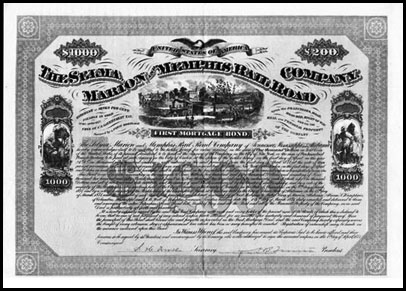 This uncancelled gold bond with new imprinted revenue combinations caused quite a stir in R.M.Smythe’s sale #188. Appearing as lot 1984, it sold for a whopping $7,150 and was signed by Nathan Bedford Forrest. In the next edition, this certificate will be numbered SEL-500-B-60.
This uncancelled gold bond with new imprinted revenue combinations caused quite a stir in R.M.Smythe’s sale #188. Appearing as lot 1984, it sold for a whopping $7,150 and was signed by Nathan Bedford Forrest. In the next edition, this certificate will be numbered SEL-500-B-60.
After chatting with George LaBarre and Scott Winslow, the story unfolded that prices had been forced up by parties promoting and buying uncancelled gold bonds as potential investments.
Why would anyone do that? Because someone thought they could make big money by cashing in gold bonds.
However, laws enacted during the 1930s create huge problems with that concept.
Gold bonds were popular from the 1880s through the 1920s, especially among large companies. The text of gold bonds promised that companies would repay both principal and interest in gold dollars having the same gold content as when bonds were originally sold. In other words, they promised a solid hedge against inflation.
The connection between gold prices and world currencies, however, had grown increasingly complex after the Silver Crash of 1893. By the late 1920s, inflation had created a two-tier system of gold pricing. World governments used fixed gold prices for inter-government trade. (The U.S. used $20.67 per ounce.) Non-government trade in gold took place at floating prices that were $5 to $15 higher. As the world fell into depression after the 1929 stock market crash, it became painfully obvious that governments could not even afford to replace their own gold coins. In fact gold coins were pouring out of free-world government treasuries by the millions.
To try to preserve American gold reserves, the Roosevelt-led U.S. Congress passed a series of protective measures. Early in 1933, the president issued an executive order that outlawed private ownership of gold coins and currency.
Shortly thereafter, on June 5, 1933 — and with little dissension — Congress passed a further measure that converted all gold debts to legal tender debts. Together, those two measures explicitly forbade companies from repaying debts in gold.
Had Congress not passed that law, every company with outstanding gold bonds would have been in bankruptcy court when the U.S. increased the official price of gold to $35 per ounce in 1935.
To understand the logic behind this latest gold bond fever, then, step into a universe with no such laws.
Let’s calculate what a typical uncancelled gold bond would be worth if it were legal to redeem it in gold. Let’s say a company issued 6% gold bonds in 1890 and went bankrupt in 1899. By compounding interest twice a year, a single $1000 bond from that period would have a cash value of $369,000 today.
If such a company had not gone bankrupt, and if the US Congress had not passed laws outlawing the process, the bonds would require a payoff in gold coins. Specifically, in gold coins having the same amount of gold they had in 1890.
Holders of such uncancelled gold bonds would demand conversion of the $369,000 cash value to 18,468 twenty dollar gold coins. Gold coins are not 100% pure so they would contain about 17,869 ounces of pure gold. Assuming gold at $300 per ounce, we’d be talking a payoff of $5,360,812 per bond!!!
Even low-interest 31/2% gold bonds unpaid since 1933 would convert to $143,000 in gold value today.
So, let me ask you this. What railroad — what company anywhere in the world — could afford that kind of payoff?
Even in this age following government bailouts of the S&L industry, can you imagine voters allowing their government to pay off defunct gold bonds at $143,000 to $5 million apiece?
Make a wild guess at how many uncancelled gold bonds might exist. And don’t forget to count registered bonds that have been destroyed prematurely.
I’ll ask again. Can you imagine a single gold bond ever being paid off ?
I’m convinced that, in human terms, there’s nothing new under the sun. This latest gold bond endeavor is not really a new invention.
The longest running effort that I can think of was one at-tempted by European “Bond Committees.” British, French, and German investors had lost hundreds of millions of dollars when the Confederacy fell in 1865. In an effort to recover money from the U.S. government, Bond Committees amassed thousands and thousands of uncancelled bonds, and lobbied tirelessly for compensation. Most of the Confederate bonds we see in today’s collectors’ market came from a hoard of 87,000 bonds that was finally broken up after 120 years.
An even more promising idea was to collect money from the state of North Carolina. That state had guaranteed several million dollars worth of railroad bonds issued during the 1870s, but reneged when those companies failed. I am not sure how long the collection effort continued, but investors were still trying to collect from the state as late as 1930. Even with court actions, no bond from that era was ever paid off.
Investment mania like this has been going on for centuries. Consider the tulip craze in the 1630s when prices for single bulbs reached $50,000 in today’s dollars. Or how about the staggering speculative runup in stock prices for the South Sea Company in 1720?
I sincerely recommend taking the long view of this cyclic hu¬man condition. If you can make the time, read A Short History of Financial Euphoria by John Kenneth Galbraith. It is a short and wonderfully-written book that will make you look at this and other faddish investments very differently. (Borrow the book from your local library or tell your bookseller to order ISBN 0-14-023856-5.)
297 New Varieties Since September!
|
1st Edition |
Currently |
New! |
| Number of certificates listed (counting all variants of issued, specimens, etc.) |
8,559 |
11,297 |
2,738 |
| Number of distinct certificates known |
7,152 |
9,069 |
1,917 |
| Number of certificates with celebrity autographs |
699 |
922 |
223 |
| Number of celebrity autographs known |
232 |
317 |
85 |
| Number of railroads and railroad-related companies known |
17,276 |
19,363 |
2,087 |
| Number of companies for which at least one certificate is known |
3,516 |
4,197 |
681 |
Wanted!!
George LaBarre Catalog 4
If you have a copy of this mail bid catalog, would you loan it to me so I can copy it?
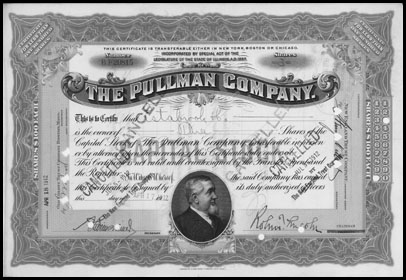
Pullman Company Stock Certificates — PUL-140
Here are the stock certificate varieties I currently know of:
| PUL-140 — Pullman Company |
| Pullman at bottom |
|
|
|
| no 'Certificate' in top margin |
|
|
|
| ABN |
< 100 shares, orange |
'19—' |
S-30 |
|
100 sh blue |
'19—' |
S-31 |
|
100 sh green |
'190–' |
S-31a |
| RBN |
<100 sh orange |
'19—' |
S-32 |
|
100 sh blue |
'19—' |
S-33 |
| 'Boston Certificate' in top margin |
|
|
|
| ABN |
odd sh gray |
'190–' |
S-40 |
| 'New York Certificate' in top margin |
|
|
|
|
<100 sh orange |
'190–' |
S-50 |
|
100 sh green |
'190–' |
S-51 |
|
100 sh green |
'1——' |
S-52 |
| Eagle at top |
|
|
|
| SBN |
odd sh brown common |
——— |
S-64 |
|
? olive |
——— |
S-60 |
|
? orange |
——— |
S-61 |
|
? green |
——— |
S-62 |
I BEG you to send me 81/2x11 copies of ANY certificates that don’t fit this scheme. Or, if you prefer, e-mail scanned images to tcox@coxrail.com
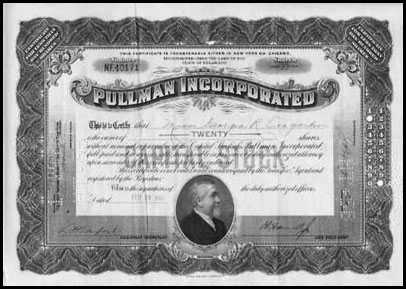
Pullman Incorporated
Unfortunately, I know even less about Pullman Incorporated certificates. Would you send me copies of ANY certificates you have from this company? I’d like to unravel the several varieties I think are out there before the next edition.
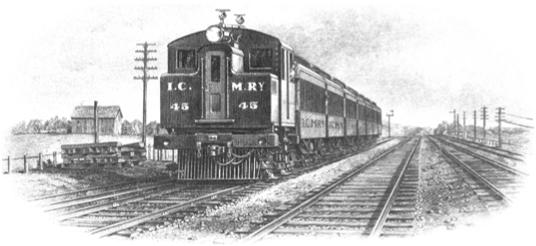 Here is a vignette from a souvenir card issued by the Middle Atlantic Numismatic Association in 1988. The loco carries the initials, 'I.C.M.Ry.' The only North American company I can find with similar initials is the Iowa Railway Coal & Manufacturing Co. Have you ever seen this image used on a certificate? Do you know what 'I.C.M.Ry' really referred to? (Since this was written in 1999, another couple of possibilities have appeared including Iron Mountain Connecting Railway and Indianapolis Chicago Meridian Railway.)
Here is a vignette from a souvenir card issued by the Middle Atlantic Numismatic Association in 1988. The loco carries the initials, 'I.C.M.Ry.' The only North American company I can find with similar initials is the Iowa Railway Coal & Manufacturing Co. Have you ever seen this image used on a certificate? Do you know what 'I.C.M.Ry' really referred to? (Since this was written in 1999, another couple of possibilities have appeared including Iron Mountain Connecting Railway and Indianapolis Chicago Meridian Railway.)
Anything New You Want Me to Talk About?
As I’m revising text for next year’s second edition, I’m adding new sections and deeper explanations. Currently, I plan to talk more about:
- colors
- paper types
- incorporation dates
- company ending dates
- reports of numbers extant
- CUSIP numbers
- aid bonds from cities, counties, states
Unfortunately, I can not include company histories. The problem is space. And space translates directly into production costs. If I added only three lines per company, my publisher would need to enlarge the volume by 100 pages. He’d probably leap at the chance if those 100 pages would increase sales dramatically. That won’t happen.
Having said that, I have nonetheless added minor descriptions such as states of incorporation and date ranges when I thought it would help you differentiate your certificates between similarly named companies.
So, what else would you like to see?
An Example to Ponder
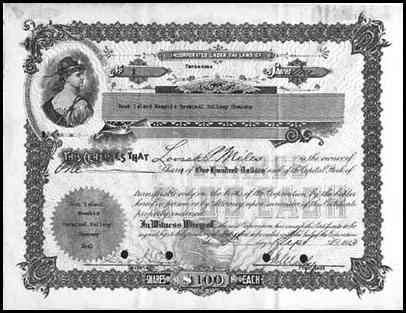 ROC-430-S-35
ROC-430-S-35
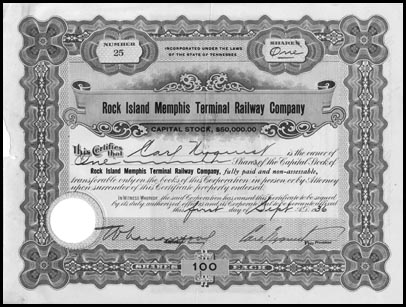 ROC-430-S-40
ROC-430-S-40
Here are examples of two certificates Ken Holter found on the internet. (I’m sorry, but I don’t know the original seller. If you’re the seller and can clarify facts, please let me know.)
The left example above is a generic certificate (S-35) for the Rock Island Memphis Terminal Railway Co. It is certificate #1 issued to Mr. Lorrick Miles on September 6, 1913. The title is typewritten. Over the gold seal is typewritten “Rock Island Memphis Terminal Railway Company Seal.” All other details are filled in by hand.
The second certificate (S-40) is from the same company and represents the “official” lithographed certificates the company used for the next several years. That certificate is also a #1. And what makes this an important and fascinating pair, is that both were made out to the same Mr. Miles and were dated the same day.
I’m guessing that soon after it issued S-35, the company replaced the generic certificates with lithographed equivalents. I would assume that at least a few weeks had elapsed, because it doesn’t make sense that both certificates were issued on the very same day. The stub at the left of S-40 clearly says that the new certificate was transferred from “Original Issue.”
2,000 New Varieties?
With your help, I think we’ll be able to add 2,000 new varieties of railroad stocks and bonds before the next edition goes to press. We added almost 300 new items in the last quarter. About half came from new submittals from readers. The other half came from auction catalogs.
Internet auction sites have added an amazing number of new items. I especially thank Ken Holter for sending me copies of those items. He has been most instrumental in covering a huge part of the field that I could not possibly cover on my own. His contributions continue to amaze me in the number of “new” items that are appearing, day after day. If you’re a serious buyer, it will behoove you to look to the internet. I’m not saying you’re going to get things dirt cheap, because you will be up against European buyers who routinely experience higher prices than here in the U.S. On the other hand, it may be years before some of these items appear again in the collectors’ market.